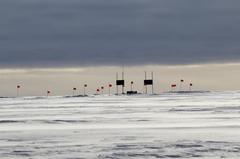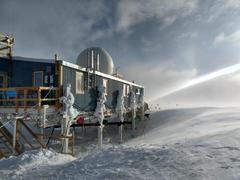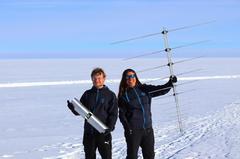URL: https://www.desy.de/news/news_search/index_eng.html
Breadcrumb Navigation
DESY News: Chasing cosmic particles with radio antennas in Greenland's ice
News
News from the DESY research centre
Chasing cosmic particles with radio antennas in Greenland's ice
In Greenland's ice sheet, a set-up unlike any other in the world will in future be listening for extremely elusive particles from space. The Radio Neutrino Observatory Greenland (RNO-G) is a pioneering project that relies on a new method of detecting very high-energy cosmic neutrinos using radio antennas. The scientists involved in the project have now installed the first antenna stations in the ice at the Summit Station research facility.

The first station of the network on the Greenland ice. The red flags mark underground antennas powered by solar panels (dark rectangles). Credit: RNO-G, Cosmin Deaconu
The ultralight elementary particles are sometimes called ghost particles because they have no trouble passing straight through walls, the Earth and even entire stars. “This property makes them interesting for astrophysicists because they can be used to look inside exploding stars or merging neutron stars, for example, from which no light can reach us,” explains Nelles, who is also a professor at Friedrich-Alexander Universität Erlangen-Nürnberg. “Also, neutrinos can be used to track down natural cosmic particle accelerators.”
On extremely rare occasions, however, a neutrino does in fact interact with matter when it happens to bump into an atom as it passes through – the Greenland ice sheet, for instance. Such rare collisions produce an avalanche of secondary particles, many of which are electrically charged, unlike the neutrino. This cascade of charged secondary particles emits radio waves that can be picked up by the antennas.

Summit Station is situated in the middle of the ice sheet. Credit: RNO-G, Cosmin Deaconu
Overall, the scientists plan to install 35 antenna stations, each 1.25 kilometres apart, around Summit Station on the mighty Greenland ice sheet. Nevertheless, it could take months or even years before the observatory records a signal. “Neutrino research calls for patience,” explains Nelles. “Capturing high-energy neutrinos is an incredibly rare event. But when you do catch one, it reveals an enormous amount of information.” The researchers are also already thinking ahead to the next step, because the next radio neutrino observatory is planned literally at the other end of the world, augmenting the IceCube neutrino telescope at the South Pole.
There, an international consortium, which includes DESY, has installed some 5000 sensitive optical detectors to depths of several kilometres inside the Antarctic ice. These photomultipliers are looking out for a faint bluish flash of light, which is also produced by the energetic secondary particles from one of the rare neutrino collisions as they race through the subterranean ice. Using this technique, IceCube has already succeeded in making some spectacular observations of neutrinos arriving from the vicinity of a gigantic black hole or shattered star, for example. The visible light from the subterranean secondary particles cannot be tracked over such long distances in the ice as radio waves. However, the photomultipliers make up for this by responding to cosmic neutrinos with lower energies.

DESY scientists Christoph Welling (l) and Ilse Plaisier (r) with a radio antenna on the Greenlandic ice sheet. Credit: RNO-G, Cosmin Deaconu
The first stage of installing the equipment for this pioneering project is due to continue until mid-August, and carrying this out during the pandemic has been a huge logistical challenge: teams have had to spend several weeks quarantined at various locations before arriving at Summit Station, to avoid introducing the coronavirus. RNO-G will remain on the Greenland ice sheet for at least five years. The individual stations can operate autonomously, powered by solar panels, and will be connected with each other via a wireless network. Based on their operation, radio antennas are planned to be added to the IceCube neutrino detector at the South Pole as part of its Generation 2 expansion (IceCube-Gen2).
“Detecting radio signals from high-energy neutrinos is a very promising way of significantly increasing the energy range we can access, and thus opening this new window to the cosmos even further,” says Christian Stegmann, DESY’s Director of Astroparticle Physics. “We are pursuing this path via initial test structures in Greenland, and will then go on to install radio antennas at the South Pole as part of IceCube-Gen2.”
More than a dozen partners are involved in the pioneering project, including the University of Chicago, Vrije Universiteit Brussel, Penn State University, the University of Wisconsin-Madison and DESY.
Further reading
- RNO-G: https://radio.uchicago.edu
- RNO-G on Twitter: https://twitter.com/rno_greenland
- IceCube-Gen2: https://www.icecube-gen2.de/index_eng.html



